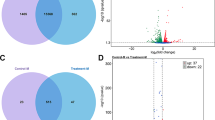Abstract
Synthetic musks are widely used in personal-care products and can readily accumulate in the adipose tissue, breast milk, and blood of humans. In this study, the Affymetrix Mouse Genome GeneChip was used to identify alterations in gene expression of embryonic stem cells from the 129 strain of the laboratory mouse after treatment with the synthetic musk tonalide (AHTN). Among the 45,037 transcripts in the microarray, 2,879 genes were differentially expressed. According to the microarray analysis, the potential influence of AHTN on the development to embryo should be of concern, and the toxicological effects of it and related musk compounds should be studied further.

Similar content being viewed by others
References
Attisano L, Wrana JL (2002) Signal transduction by the TGF-beta superfamily. Science 296:1646–1647
Bitsch N, Dudas C, Körner W, Failing K, Biselli S, Rimkus G, Brunn H (2002) Estrogenic activity of musk fragrances detected by the E-Screen assay using human MCF-7 cells. Arch Environ Contam Toxicol 43:257–264
Carlsson G, Norrgren L (2004) Synthetic musk toxicity to early life stages of zebrafish (Danio rerio). Arch Environ Contam Toxicol 46:102–105
Kannan K, Reiner JL, Yun SH, Perrotta EE, Tao L, Johnson-Restrepo B, Rodan BD (2005) Polycyclic musk compounds in higher trophic level aquatic organisms and humans from the United States. Chemosphere 61:693–700
Missaoui N, Hmissa S, Trabelsi A, Traoré C, Mokni M, Dante R, Frappart L (2011) Promoter hypermethylation of CDH13, DAPK1 and TWIST1 genes in precancerous and cancerous lesions of the uterine cervix. Pathol Res Pract 207:37–42
Mori T, Inokuchi A, Nihira M, Yamamoto R, Ishibashi H, Kohra S, Tominaga N, Arizono K (2007) Eco-toxicological effect of polycyclic musks for C. elegans. JSAAE 14(Special issue):569–573
Nakata H, Sasaki H, Takemura A, Yoshioka M, Tanabe S, Kannan K (2007) Bioaccumulation, temporal trend, and geographical distribution of synthetic musks in the marine environment. Environ Sci Technol 41:2216–2222
Reiner JL, Wong CM, Arcaro KF, Kannan K (2007) Synthetic musk fragrances in human milk from the United States. Environ Sci Technol 41:3815–3820
Roux PP, Blenis J (2004) ERK and p38 MAPK-activated protein kinases: a family of protein kinases with diverse biological functions. Microbiol Mol Biol Rev 68:320–344
Scholz G, Genschow E, Pohl I, Bremer S, Paparella M, Raabe H, Southee J, Spielmann J (1999) Prevalidation of the embryonic stem cell test(EST)-a new in vitro embryotoxicity test. Toxicol In Vitro 13:675–681
Schreurs RH, Sonneveld E, Jansen JH, Seinen W, van der Burg B (2005) Interaction of polycyclic musks and UV filters with the estrogen receptor (ER), androgen receptor (AR), and progesterone receptor (PR) in reporter gene bioassays. Toxicol Sci 83:264–272
Seinen W, Lemmen JG, Pieters RH, Verbruggen EM, van der Burg B (1999) AHTN and HHCB show weak estrogenic-but no uterotrophic activity. Toxicol Lett 111:161–168
Shek WM, Murphy MB, Lam JC, Lam PK (2008) Polycyclic musks in green-lipped mussels (Perna viridis) from Hong Kong. Mar Pollut Bull 57:373–380
Sumner NR, Guitart C, Fuentes G, Readman JW (2010) Inputs and distributions of synthetic musk fragrances in an estuarine and coastal environment; a case study. Environ Pollut 158:215–222
van Dartel DAM, Pennings JLA, de la Fonteyne LJJ, van Herwijnen MH, van Delft JH, van Schooten FJ, Piersma AH (2010) Monitoring developmental toxicity in the embryonic stem cell test using differential gene expression of differentiation-related genes. Toxicol Sci 116:130–139
van der Burg B, Schreurs R, Linden S, Seinen W, Brouwer A, Sonneveld E (2008) Endocrine effects of polycyclic musks: do we smell a rat? Int J Androl 31:188–193
Wei YH, Shi XJ, Zhang HX, Wang JS, Zhou BS, Dai JY (2009) Combined effects of polyfluorinated and perfluorinated compounds on primary cultured hepatocytes from rare minnow (Gobiocypris rarus) using toxicogenomic analysis. Aquat Toxicol 95:27–36
Yasuaki M, Tomohiro U, Shizu H, Hayato T, Atsushi A, Shigeki K, Akihiro N, Katsuhiko N (2010) Reduced fertility with impairment of early-stage embryos observed in mice lacking Lgr4 in epithelial tissues. Fertil Steril 94:2878–2881
Acknowledgments
This study was supported by grants from National Natural Science Foundation of China (20877010 and 20837003).
Author information
Authors and Affiliations
Corresponding author
Rights and permissions
About this article
Cite this article
Shi, J., Li, M., Jiao, Z. et al. Microarray Analysis of Gene Expression in Mouse (Strain 129) Embryonic Stem Cells After Typical Synthetic Musk Exposure. Bull Environ Contam Toxicol 90, 17–21 (2013). https://doi.org/10.1007/s00128-012-0865-7
Received:
Accepted:
Published:
Issue Date:
DOI: https://doi.org/10.1007/s00128-012-0865-7




